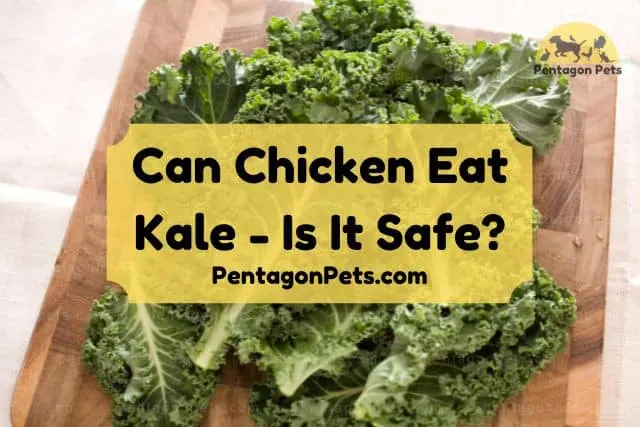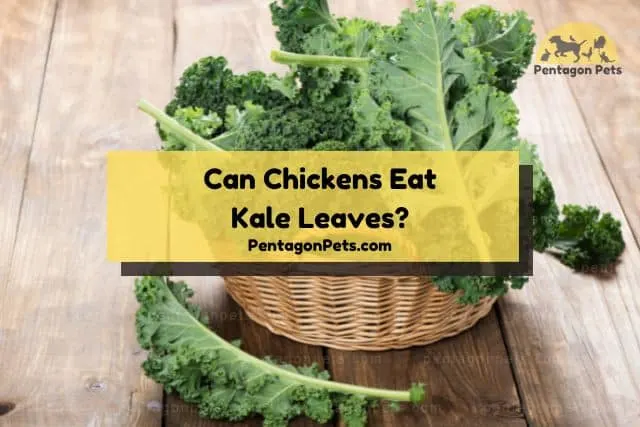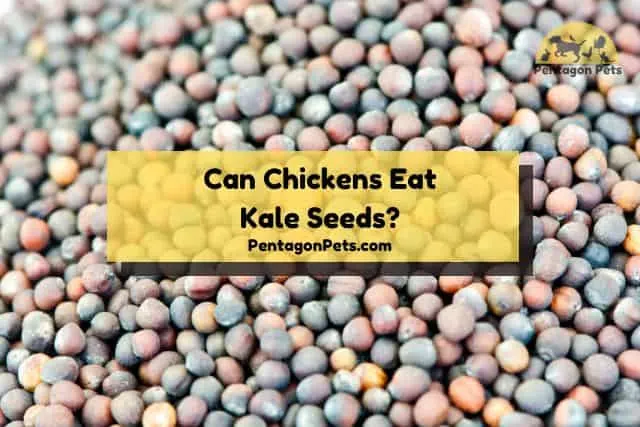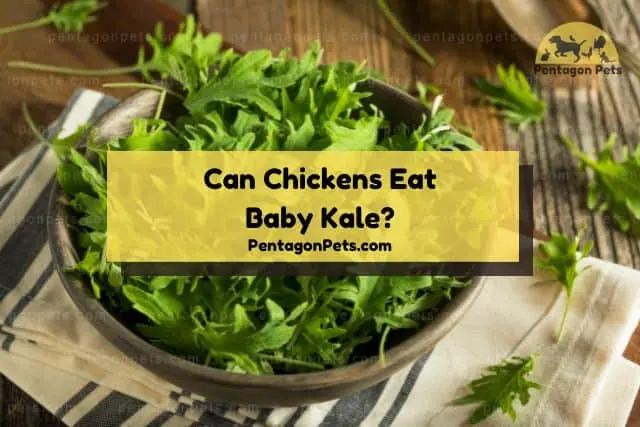When you first begin keeping chickens, the question of what to feed them comes up. Many sites say besides their chicken feed as a main meal, table scraps work fine as a snack, but what table scraps? Can chicken eat kale? Is it safe?
Yes, chickens can eat kale. It’s a nutritious snack rich in vitamins A, C, and K, calcium, and antioxidants. Kale should be given in moderation as part of a balanced diet, ensuring it’s clean and pesticide-free.
Kale is a great addition to a chicken’s diet, providing essential nutrients that contribute to their overall health. It’s especially beneficial during the colder months when fresh greens are scarce. Offering kale can help diversify their diet, which is important for their digestive health. It’s best served chopped or torn into smaller pieces to make it easier for the chickens to eat. You can also hang it in their coop to encourage natural foraging behavior.

Young chickens can’t yet snack on what adult chickens do. For the first six weeks of a chick’s life, it should eat chick starter, a mash specifically designed for its growth and digestive tract composed of 20 protein for laying breeds or 22 to 24 percent protein for meat birds. Some sources okay feeding a tiny bit of kale leaf per chick as a treat at three weeks of age, but warn that they don’t yet have the digestive tract for it yet.
From week seven to 14, they dine on grower pullets designed for either laying or meat birds. From 15 to 22 weeks of age, the kids need pullet developer feed or finisher, which contains lower protein content.
Adult maturity for chickens occurs about week 22. At this point, they’ve developed fully and can eat either layer rations or broiler rations for their main meal, depending on whether they are raised for eggs or as poultry birds. At this age, they can begin snacking on nearly anything, including kale and baby kale.
Is It Safe for Chicken to Eat Kale; Should Your Chicken Have it?
Chickens attempt to eat everything. Laying hens especially love to peck away at the ground for worms, bugs, seeds, etc. A short list of items chickens shouldn’t eat includes avocado and citrus fruits.
Chickens can eat kale. This high-protein green, leafy vegetable offers three to seven grams of protein per serving. Adult chickens need protein to comprise 16 to 22 percent of their diet.
Chickens love green, leafy vegetables like kale, lettuce, and spinach. You can safely feed even wilted salad greens to a chicken or rooster.
What to Look Out for When Feeding Chicken with Kale
You won’t find gourmet attitudes and tastes among chickens and roosters. They will eat Styrofoam if it blows into their yard. That means you need to carefully monitor what goes into the chicken coop.
Memorize the short list of foods they cannot safely eat and make sure they don’t get kale scraps that include any of those ingredients, such as avocados or chicken.
Like cats, chickens cannot eat chocolate safely, including mole sauce. Potato and citrus peels also make the ban list, as does any processed food. They can’t digest avocados and raw potatoes poison them with glycoalkaloids. Never feed a chicken any chicken. Even cooked chicken can spread disease among them as it constitutes cannibalism. Finally, they can’t have pure salt, coffee, coffee grounds, or soda pop.
For example, many salads include kale, lettuce, and avocado. In this case, because of the avocado, you can’t feed the chickens the wilted greens or leftover salad. If it had not contained the avocado, you could. Similarly, any dish prepared with processed ingredients or chicken can’t go to the chickens.
Can Chickens Eat Kale Stems?

People use kale stems to make kale chips or in a similar way to celery sticks. They taste milder than the leaves.
Your chickens will also enjoy kale stems. Chop them into chunks before tossing them out into the chicken coop. The stems contain vitamin K, great for bone health, and vitamin C to boost immunity.
Can Chickens Eat Kale Leaves?

Kale leaves taste great with chard in a salad. Sometimes you buy so much in a bunch that it wilts though.
Your chicken will appreciate those wilted greens. Laying chickens adore kale leaves. The leaves contain fewer nutrients and protein than stems.
Try growing curly kale, dinosaur kale, redbor kale, and Russian kale. The latter proves tough to find in stores, but you can grow it nearly anywhere as long as you do so indoors.
Can Chickens Eat Kale Flowers?

Flowering kale, also called ornamental kale, comes in pinks and purples infused with white and bright green. As gorgeous as it looks, don’t eat it. This ruffly flower with feathery leaves looks great in any garden though.
Do not feed chickens ornamental kale or ornamental cabbage. This inedible plant doesn’t offer the same properties as its agricultural product cousins.
Conversely, you can eat the tiny yellow kale buds on a curly kale plant. They appear at the end of the growing season. Similar to broccoli Raab, you prepare them in a similar way.
Can Chickens Eat Kale Seeds?

Kale seeds for edible kale provide a crunchy snack. Humans don’t typically eat them. You might need them for planting, but if you don’t want to use them that way, re-purpose them away.
Your chicken can make a fine snack out of the seeds of edible kale. You should not feed them ornamental kale or cabbage seeds though.
Can Chickens Eat Baby Kale?

Nearly every grocery store carries bundles of baby kale now. This ubiquitous plant offers terrific nutrition, but buy organic if you can. Otherwise, thoroughly wash your kale before using it for any meal.
Clean your baby kale carefully. Most of the agricultural producers growing baby kale use pesticides. It’s vital to wash the vegetables before feeding them to your chickens.
Can Chickens Eat Curly Kale?

Curly kale and leafy cabbage refer to the same plant. Since the Middle Ages, livestock and humans have eaten curly kale.
Just as livestock can dine on curly kale, so can your chickens. This grows easily, so plant some on a small farm for a healthy, plant-based protein for your chickens and other livestock.
Can Chickens Eat Frozen Kale?

Frozen food typically refers to processed foods. Did you grow the kale, then harvest it and freeze it? Or did you buy it frozen in a store?
This article was first published on August 19, 2022 by Pentagon-Pets.
Unless you grew the kale yourself and froze it, you should not feed it to your chickens. Fresh kale works great, but any type of processed food, even kale, chickens cannot handle.
Can Chickens Eat Cooked Kale?

Most kale comes as leafy, soft greens, easily eaten as soon as washed. Red Russian kale takes a little preparation though, since it grows tougher than the other varieties. It requires cooking to make it tender.
Chickens can eat cooked kale safely. Don’t use much, if any, salt on the kale though, because they can’t handle salt. You can safely boil or sauté it or serve it to them raw.
Can Chickens Eat Uncooked Kale?
Uncooked kale, whether fresh from the ground or from the produce aisle of the store, offers a tasty treat for man and beast. You might end up with a larger bunch of this nutrient-rich vegetable than you can eat alone.
Feed your chickens raw edible kale. Just wash them before you feed them. Tearing it into pieces will also make the chickens enjoy it more. They like foods they can peck.
Pentagon Pet is the owner of this article that was first published on August 19, 2022.
Snacks like kale should only comprise 10 percent of their diet though. The 90 percent needs to come from mash or millet made for chickens.
Related Articles
Can Chicken Eat Squash? – Is It Safe?
Can Chicken Eat Avocado? – Is It Safe?
Can Chicken Eat Sunflower – Is It Safe?
Can Chicken Eat Flax – Is It Safe?
This article and its contents are owned by Pentagon Pets and was first published on August 19, 2022.
